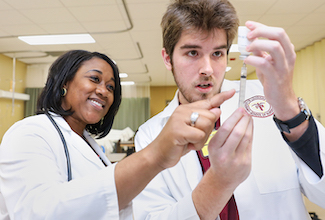
Nursing is the hands-on, face-to-face interaction between healthcare professionals and patients. Nursing students learn the practices and procedures of patient care during “clinicals” – the hours they work in hospitals and healthcare facilities.

When COVID-19 halted student nurses from joining professional nurses on the job, the Kitty DeGree School of Nursing found an innovative solution to meet the clinical requirements of coursework.
Wendy Bailes, Ph.D., RN, Director of the School of Nursing, said when she realized the nursing classes would be going online, she met with faculty to determine the best course of action, and to avoid any expense to the students.
The answer was the purchase of interactive software, Shadow Health. Faculty quickly learned the program and adapted it to their specific courses by creating PowerPoints, voiceover instructions, and incorporating case studies. Classes and individual groups are meeting via Zoom.
“Both faculty and students have embraced this new way of learning. It is not ideal; we miss not being in the hospitals and helping at this time. But, we are continuing to ensure that our students progress and graduate, as they meet competencies. For those students who lacked an ability to go online due to not having a device, we provided an iPad to get them through these next few weeks,” Bailes said.
Katie Daigle, MSN, RN, Assistant Professor of Nursing, teaches Nursing Synthesis and describes Shadow Health as “a critical resource in moving the clinical component of our course to the online platform.”
Assignments and case studies teach students critical thinking and essential concepts, said Daigle, “However, Shadow Health is the next best thing to real patient interaction. It is a simulated online program that students use to assess and interview patients. They speak or type their questions to the patient, and the patient responds based on what the student said. They even get experience dealing with patients who are less compliant.”
The software instruction includes patient education and proper administration of medication. The student’s performance is graded, and feedback is provided. The student and the instructor can access the student’s work for their grades and see where the student is proficient. Students also complete weekly self-evaluations.
“The feedback from students has been great. This is what one student had to say, ‘I personally love Shadow Health. Although the scenarios are online, the patient-nurse interactions are so realistic. Practicing the flow of conversation and assessment is helping me to become a more proficient nurse. I like having the ability to redo these assignments because I can see what needs improvement when I review,’” Daigle said.
Assistant Professor Marcie Young, MSN, RN, teaches Nursing Management to students in their final semester. During this last step of their nursing school journey, the students are applying all they have learned. The management strategies range from prioritization to communication skills.
“The Shadow Health module Nursing Leadership provides students with simulated scenarios utilizing delegation, conflict resolution, patient interviewing skills, critical thinking scenarios, and the ability to review and document in an electronic health record,” Young said.
She also uses Swift River software.
“The Swift River modules simulate emergency room leadership through triage processes, prioritization, and safe medication administration,” Young said.
Movies, discussion board forums, and self-reflection journals have also been incorporated into the course.
“I believe that students are being exposed to critical leadership skills that are not always presented to them in the traditional clinical setting. Since most of the traditional students are from the millennial generation, they have been very comfortable with the technology and have received extensive feedback through the simulation programs and instructors,” she said.